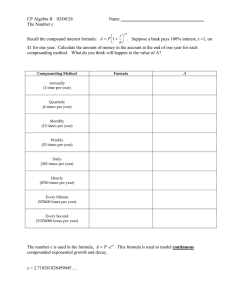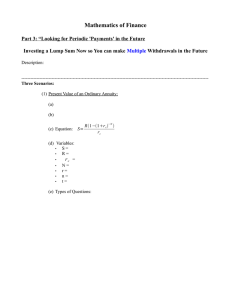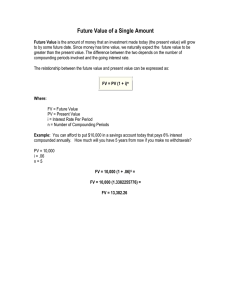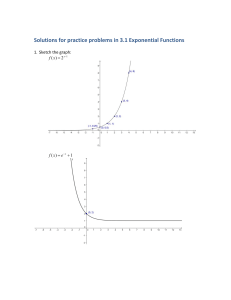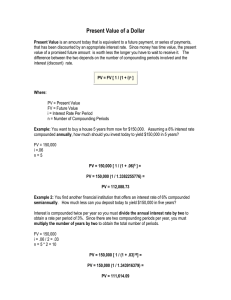Methods of Calculating Interest
advertisement
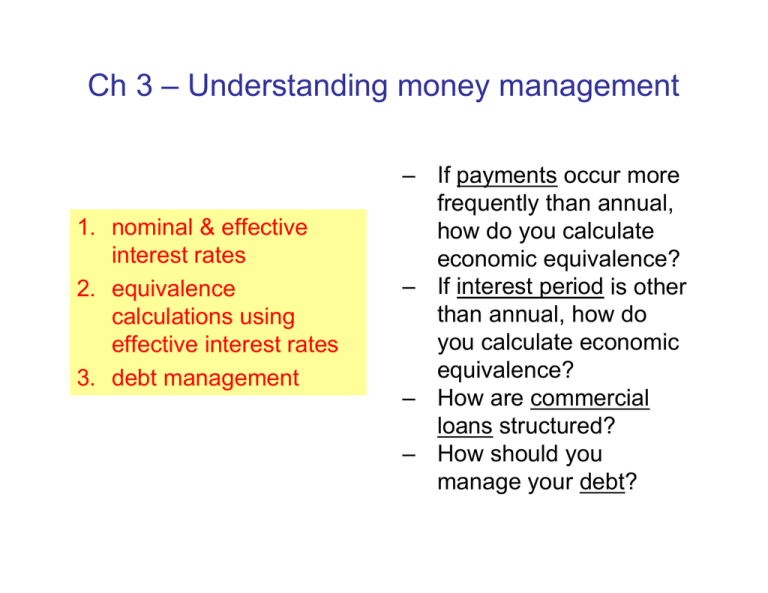
Ch 3 – Understanding money management 1. nominal & effective interest rates 2. equivalence calculations using effective interest rates 3. debt management – If payments occur more frequently than annual, how do you calculate economic equivalence? – If interest period is other than annual, how do you calculate economic equivalence? – How are commercial loans structured? – How should you manage your debt? Nominal vs. effective interest rates Nominal interest rate: rate quoted based on an annual period (APR) Effective interest rate: actual interest earned or paid in a year (or some other time period) Example: 18% compounded monthly – interest rate per month: i = 18%/12 = 1.5% – no. interest periods per year: N = 12 – borrow: bank charges 1.5% interest each month on your unpaid balance – deposit: you earn 1.5% interest each month on your remaining balance 18% compounded monthly Question: Suppose that you invest $1,000 for 1 year at 18% compounded monthly. How much interest would you earn? F = $1,000(1 + i)N = $1,000(1 + 0.015)12 = $1,195.60 i = 0.1956 Æ 19.56% 18% 1 2 3 4 = 1.5% 5 6 7 8 9 10 11 12 Effective annual interest rate (yield) ia = (1 + r/M)M - 1 r = nominal interest rate per year (APR) ia = effective annual interest rate M = number of interest periods per year 18% 1 2 3 4 5 6 7 8 9 10 11 12 18% compounded monthly Î 1.5% per month for 12 months = 19.56 % compounded annually Practice problems – If your credit card calculates interest based on 12.5% APR, what are your monthly interest rate & annual effective interest rate? – If your credit card’s current outstanding balance is $2,000 & you decide to skip payments for 2 months, what would be the total balance 2 months from now? monthly: i = 12.5% 12 = 1.0417% effective annual: ia = (1 + 1.010417)12 = 13.24% balance in 2 mo.: F = $2,000(F/P, 1.0417%,2) = $2,041.88 Practice problem Suppose your savings account pays 9% interest compounded quarterly. If you deposit $10,000 for one year, how much would you have at the end of the year? Practice problem Suppose your savings account pays 9% interest compounded quarterly. If you deposit $10,000 for one year, how much would you have at the end of the year? (a) Interest rate per quarter: 9% i= = 2.25% 4 (b) Annual effective interest rate: ia = (1 + 0.0225) 4 − 1 = 9.31% (c) Balance at the end of one year (after 4 quarters) F = $10, 000( F / P , 2.25%, 4) = $10, 000( F / P , 9.31%,1) = $10, 9 31 Brute force method of solution First quarter base amount + interest (2.25%) $10,000 + $225 Second quarter = new base amount + Interest (2.25%) = $10,225 +$230.06 Third quarter = new base amount + Interest (2.25%) = $10,455.06 +$235.24 Fourth quarter = new base amount + interest (2.25 %) = value after one year = $10,690.30 + $240.53 = $10,930.83 Effective annual interest rate (9% compounded quarterly) Example 3.4: Calculating auto loan payments Given: Invoice price = $21,599 Sales tax at 4% = $21,599 (0.04) = $863.96 Dealer’s freight = $21,599 (0.01) = $215.99 Total purchase price = $22,678.95 Down payment = $2,678.95 Dealer’s interest rate = 8.5% APR, monthly compounding Length of financing = 48 months Find: monthly payment Solution: Payment period = Interest period $20,000 1 2 3 4 48 0 A Given: P = $20,000, r = 8.5% per year K = 12 payments per year N = 48 payment periods Find A: M = 12 compounding periods per year: i = r/M = 8.5%/12 = 0.7083% per month N = (12)(4) = 48 months, or payment periods A = $20,000(A/P, 0.7083%,48) = $492.97 Suppose you want to pay off the remaining loan in lump sum right after making the 25th payment. How much would this lump be? $20,000 1 2 48 24 25 0 $492.97 25 payments that were already made $492.97 23 payments that are still outstanding P = $492.97 (P/A, 0.7083%, 23) = $10,428.96 Practice problem You have a habit of drinking a cup of Starbuck coffee ($2.00 a cup) on the way to work every morning for 30 years. If you put the money in the bank for the same period, how much would you have, assuming your accounts earns 5% interest compounded daily. NOTE: Assume you drink a cup of coffee every day including weekends. Practice problem You have a habit of drinking a cup of Starbuck coffee ($2.00 a cup) on the way to work every morning for 30 years. If you put the money in the bank for the same period, how much would you have, assuming your accounts earns 5% interest compounded daily. NOTE: Assume you drink a cup of coffee every day including weekends. 5% i= = 0.0137% per day 365 N = 30 × 365 = 10,950 days F = $2( F / A, 0.0137%,10950) = $50,831 Effective interest rate per payment period payment period interest period payment period interest period payment period interest period Effective interest rate per payment period i = [1 + r/CK]C - 1 C = number of interest periods per payment period K = number of payment periods per year CK = total number of interest periods per year, or M r / K = nominal interest rate per payment period 12% compounded monthly, quarterly payments One year 1st 2nd 3rd 1% 1% 1% 3.03% 12.68% Effective interest rate per quarter i = (1 + 0 . 01 ) 3 − 1 = 3 . 030 % Effective annual interest rate i a = ( 1 + 0 .0 1 ) 1 2 − 1 = 1 2 .6 8 % i a = ( 1 + 0 .0 3 0 3 0 ) 4 − 1 = 1 2 .6 8 % 4th Effective interest rate per payment period w/ continuous compounding i = [(1 + r/CK)C – 1] CK = number of compounding periods per year for continuous compounding: C Æ ∞ i = lim[(1 + r/CK)C – 1] = (er)1/K - 1 Example: effective interest rate per quarter i = [(1 + r/CK)C – 1] r = 0.08 K = 4 payments per year compound quarterly compound monthly compound weekly compound continuously CÆ∞ C=1 M=4 C=3 M = 12 C = 13 M = 52 i = [1 + 0.08/4]1 -1 i = [1 + 0.08/12]3 -1 i = [1 + 0.08/52]13 -1 i = e0.02 -1 2.000% per qtr 2.013% per qtr 2.0186% per qtr 2.0201% per qtr Example 3.5 – Discrete case: quarterly deposits with monthly compounding F=? Suppose you make equal quarterly deposits of $1,000 into a fund that pays interest at 12% compounded monthly. Find the balance at the end of year 3. Year 1 0 1 2 3 4 Year 2 5 6 7 Year 3 8 9 10 11 12 A = $1,000 quarters M = 12 compounding periods/year K = 4 payment periods/year C = 3 interest periods per quarter i = [1 + 0 .12 /( 3)( 4 )] 3 − 1 = 3 .030 % N = 4(3) = 12 F = $1,000 (F/A, 3.030%, 12) = $14,216.24 Continuous case: Quarterly deposits with continuous compounding Year 1 0 1 2 3 Year 2 4 5 6 7 Year 3 8 F=? 9 10 11 12 quarters A = $1,000 K = 4 payment periods/year C = ∞ interest periods per quarter i = e0.12/ 4 − 1 = 3.045% per quarter N = 4(3) = 12 F = $1,000 (F/A, 3.045%, 12) = $14,228.37 Practice problem A series of equal quarterly payments of $5,000 for 10 years is equivalent to what present amount at an interest rate of 9% compounded a. quarterly b. monthly c. continuously A = $5,000 0 1 2 40 Quarters Quarterly A = $5,000 Payment period : Quarterly Interest Period: Quarterly 0 1 2 40 Quarters 9% i= = 2.25% per quarter 4 N = 40 quarters P = $5,000( P / A, 2.25%, 40) = $130,968 Monthly A = $5,000 Payment period : Quarterly Interest Period: Monthly 0 1 2 40 Quarters 9% i= = 0.75% per month 12 i p = (1 + 0.0075)3 = 2.267% per quarter N = 40 quarters P = $5,000( P / A, 2.267%, 40) = $130,586 Continuously A = $5,000 Payment period : Quarterly Interest period: Continuously 0 1 2 40 Quarters i = e0.09/ 4 − 1 = 2.276% per quarter N = 40 quarters P = $5,000( P / A, 2.276%, 40) = $130,384 Example 3.7 – Loan repayment schedule For a $5,000 loan repaid over 2 years at 12% develop the monthly loan repayment schedule showing interest & principal for each period. $5,000 A = $5,000(A/P, 1%, 24) = $235.37 1 2 3 4 5 6 7 i = 1% per month 22 23 24 0 A = $235.37 Consider the 7th payment ($235.37) a. How much is interest? b. What is the amount of principal payment? Solution How much is interest? What is the amount of principal payment? W O utstanding balance at the end of period 6: (N ote: 18 outstanding paym ents) B 6 = $235.37 ( P / A ,1% ,18) = $3, 859.66 W Interest paym ent for period 7: IP7 = $3, 859.66(0.01) = $38.60 W P rincipal paym ent for period 7: P P7 = $235.37 − $38.60 = $196.77 N ote: IP7 + P P7 = $235.37 A B C D E F 1 2 3 4 5 6 7 8 Exam ple 3.7 C ontract am ount C ontract period APR (% ) M onthly Paym ent Loan Repaym ent Schedule $ 5,000.00 24 12 ($235.37) T otal paym ent T otal interest $ 5,648.82 $648.82 9 10 11 12 13 14 15 16 17 18 19 20 21 22 23 24 25 26 27 28 29 30 31 32 33 34 35 Paym ent N o. 1 2 3 4 5 6 7 8 9 10 11 12 13 14 15 16 17 18 19 20 21 22 23 24 Paym ent Size ($235.37) ($235.37) ($235.37) ($235.37) ($235.37) ($235.37) ($235.37) ($235.37) ($235.37) ($235.37) ($235.37) ($235.37) ($235.37) ($235.37) ($235.37) ($235.37) ($235.37) ($235.37) ($235.37) ($235.37) ($235.37) ($235.37) ($235.37) ($235.37) Principal Paym ent ($185.37) ($187.22) ($189.09) ($190.98) ($192.89) ($194.82) ($196.77) ($198.74) ($200.73) ($202.73) ($204.76) ($206.81) ($208.88) ($210.97) ($213.08) ($215.21) ($217.36) ($219.53) ($221.73) ($223.94) ($226.18) ($228.45) ($230.73) ($233.04) Interest paym ent ($50.00) ($48.15) ($46.27) ($44.38) ($42.47) ($40.54) ($38.60) ($36.63) ($34.64) ($32.63) ($30.61) ($28.56) ($26.49) ($24.40) ($22.29) ($20.16) ($18.01) ($15.84) ($13.64) ($11.42) ($9.18) ($6.92) ($4.64) ($2.33) Loan Balance $4,814.63 $4,627.41 $4,438.32 $4,247.33 $4,054.44 $3,859.62 $3,662.85 $3,464.11 $3,263.38 $3,060.65 $2,855.89 $2,649.08 $2,440.20 $2,229.24 $2,016.16 $1,800.96 $1,583.60 $1,364.07 $1,142.34 $918.40 $692.21 $463.77 $233.04 $0.00 G Example 3.9 buying versus lease decision debt financing Lease financing Price $14,695 $14,695 Down payment $2,000 0 APR (%) Monthly payment Length 3.6% $372.55 $236.45 36 months 36 months Fees $495 Cash due at lease end $300 Purchase option at lease end Cash due at signing $8.673.10 $2,000 $731.45 Accounting data - buying vs. lease Cash outlay for buying : $25,886 Down payment: $2,100 Car Loan at 8.5% (48 payments of $466): $22,368 Sales tax (at 6.75%): $1,418 Cash outlay for leasing : $15,771 Lease (48 payments of $299) : $14,352 Sales tax (at 6.75%): $969 Document fee: $450 Refundable security deposit (not included in total) : $300 Which interest rate to use to compare these options? Your earning interest rate = 6% Debt financing: Pdebt = $2,000 + $372.55(P/A, 0.5%, 36) - $8,673.10(P/F, 0.5%, 36) = $6,998.47 Lease financing: Please = $495 + $236.45 + $236.45(P/A, 0.5%, 35) + $300(P/F, 0.5%, 36) = $8,556.90 Summary – Financial institutions often quote interest rate based on an APR. – In all financial analysis, we need to convert the APR into an appropriate effective interest rate based on a payment period. – When payment period and interest period differ, calculate an effective interest rate that covers the payment period. Then use the appropriate interest formulas to determine the equivalent values
